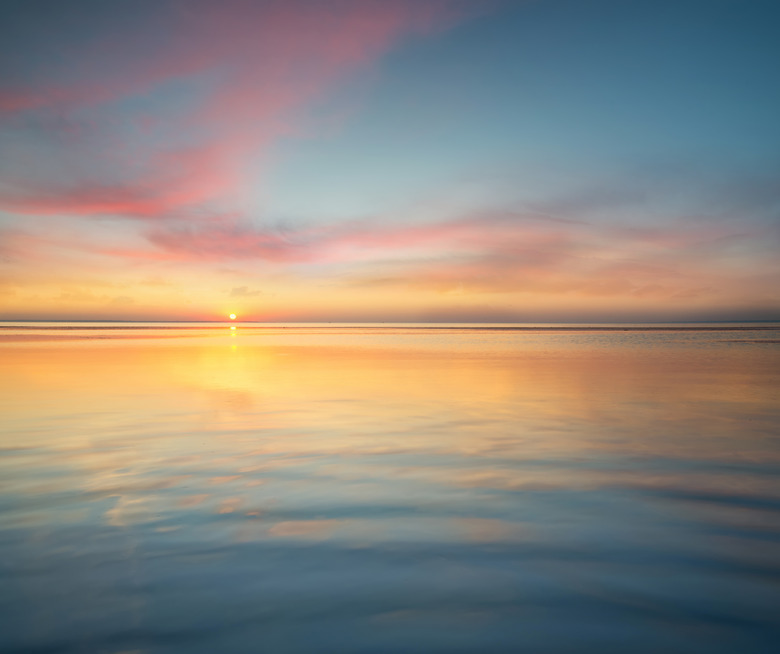Three Major Characteristics Of The Inner Planets
The four inner planets — Mercury, Venus, Earth and Mars — share several features in common. Astronomers call them "terrestrial planets" because they have solid, rocky surfaces roughly similar to desert and mountainous areas on the earth. The inner planets are much smaller than Jupiter, Saturn, Uranus and Neptune, and they all possess iron cores.
The easiest spatial distinction between the inner planets and outer planets in the solar system is the asteroid belt. All four of the terrestrial planets fall within the asteroid belt (closer to the sun), and all the gas giants, dwarf planets, and other planets of our solar system (there might be more we have not discovered yet!) fall outside the asteroid belt.
TL;DR (Too Long; Didn't Read)
Inner planets are much smaller than the outer planets, and are rocky with an iron core.
Terrestrial Planet Formation
Terrestrial Planet Formation
Astronomers theorize that the very early solar system formed as a ring of materials surrounding the sun. Heavier elements such as iron and nickel condensed relatively close to the sun, whereas substances such as hydrogen, methane and water condensed in colder regions farther out. These rocky planets formed as clumps of debris and heavy elements from the inner ring of materials accumulated due to gravitational attraction; in a similar way, the outer band of gaseous substances produced the outer planets.
TL;DR (Too Long; Didn't Read)
The outer planets, or gas giants, are also sometimes called the Jovian planets.
Size Range
Size Range
Compared to the four gas giant planets that make up the outer solar system, the inner planets all have diminutive sizes. Of the four, Earth is the largest, with a diameter of 6,378 kilometers (3,963 miles) at the equator. Venus is a close second at 6,051 kilometers (3,760 miles). Mars is much smaller with a 3,396-kilometer (2,110-mile) diameter, and Mercury is the smallest terrestrial planet, measuring 2,439 kilometers (1,516 miles) across.
Some of the largest moons in the solar system, Ganymede and Titan, are actually larger than Mercury, and there are dwarf planets like Pluto and Ceres that begin to approach a similar size (although they are still significantly smaller).
Rocky Surface
Rocky Surface
The terrestrial planets all have rocky surfaces that feature mountains, plains, valleys and other formations. The temperatures of the inner planets are low enough that rock exists mostly as a solid at the surface. To different degrees, they also have meteor impact craters, although the dense atmospheres of Venus and Earth protect them from most meteors, and weathering and other factors wipe out all but the most recent craters. Mars has very low atmospheric pressure, and Mercury has almost none, so craters are more common on these planets.
TL;DR (Too Long; Didn't Read)
These thin atmospheres also make their surfaces more easily visible using tools on Earth.
NASA provides incredible images of all of these planet's surface features, or in the case of Venus, the thick atmosphere that surrounds it. Mercury has an appearance very similar to the Earth's moon, pockmarked with craters. Venus is shrouded in clouds and dense gas; this thick skin creates a greenhouse effect, raising the surface temperature to be the hottest planet in the solar system. Earth's atmosphere sports a very familiar combination of gases and water vapor, and Earth's surface is a variety of liquid water oceans and terrestrial land. Mars might appear more uniform on the surface, but it also contains some of the literal highest highs and lowest lows in the solar system. The martian topography is home to the tallest mountain in the solar system – Olympus Mons, and it also contains some of the deepest canyons.
Metal Core
Metal Core
Astronomers believe all four of the terrestrial planets possess an iron core. During their early formation, the planets were hot blobs of molten metals and other elements; being heavier, most of the iron and nickel ended up on the inside with lighter elements such as silicon and oxygen forming the outside. Geologists have concluded that the earth's iron core is partly liquid and partly solid by observing the behavior of earthquake waves traveling through the earth. Scientists speculate that the other terrestrial planets may also have partly liquid cores.
TL;DR (Too Long; Didn't Read)
These metal cores are thought to produce the magnetic fields that are very characteristic of these smaller, heavily metallic planets.
Not Everything is Constant
Not Everything is Constant
The terrestrial planets also differ in many regards. Earth and Mars both have satellite moons (with Mars capturing two small moons and Earth having the iconic Moon). Earth and Mars are also thought to be the only two planets with water ice or some form of water (Mars also has frozen carbon dioxide at the poles). Meanwhile, while all four planets are the densest bodies in the solar system, Mars is actually much lighter than the other three – with about 60% the density of Earth and Venus. Earth is the only planet in the solar system with confirmed signs of life.
Cite This Article
MLA
Papiewski, John. "Three Major Characteristics Of The Inner Planets" sciencing.com, https://www.sciencing.com/three-major-characteristics-inner-planets-12917/. 16 June 2023.
APA
Papiewski, John. (2023, June 16). Three Major Characteristics Of The Inner Planets. sciencing.com. Retrieved from https://www.sciencing.com/three-major-characteristics-inner-planets-12917/
Chicago
Papiewski, John. Three Major Characteristics Of The Inner Planets last modified June 16, 2023. https://www.sciencing.com/three-major-characteristics-inner-planets-12917/
